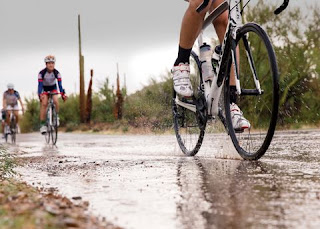Until a few days ago, I thought a blockchain had something to do with construction machinery or power tools. Turns out, it's very high tech. In fact, it is a core component of the Bitcoin.
As I understand it, the "block" is a growing list of digital records linked by using cryptography. Each block contains a cryptographic hash of the previous block, a timestamp and transaction data. By its design, the cryptographic hash is a one-way function, meaning that it is impossible to invert, i.e., alter.
Each of the blocks is linked using cryptography. The blocks can originate from any number of sources and can be transmitted to others. As an example, a block can be sent from the owner of an object to the police and an insurance company.
You can see where this is going, right?
IBM is working on a system that will allow a bike's owner to register his or her machine via an app. That information would also be stored on a "smart" lock that would provide the location of the bike when it's parked--and allow transmission of that data to the concerned parties (owner, police and insurer) if the bike is stolen.
Currently, reporting a stolen bike is a cumbersome process in the US and Europe, as Louis de Bruin explains. "Many interactions are required to exchange information that all these parties do not have at hand," said the IBM Blockchain Lead for Europe. The blockchain "simplifies the process," he said, because "all information about the stolen bicycle and owner are recorded on the blockchain and available for all parties to access at the right moment."
That IBM is trying this system first in the Netherlands, via IBM Benelux, is not surprising. After all, there are more bicycles than people in the low-lying nation, and theft is a problem, particularly in Amsterdam. But IBM sees the potential, not only for individual bike owners, but for owners of rental or bike-share fleets. In some cities, such as Rome, bike-share programs were halted because of theft and vandalism.
Of course, such a system could also be used to aid in recovering other stolen items, and in detecting counterfeit items. But it's fascinating to see that, if such a system works, cyclists might be its early adopters.
As I understand it, the "block" is a growing list of digital records linked by using cryptography. Each block contains a cryptographic hash of the previous block, a timestamp and transaction data. By its design, the cryptographic hash is a one-way function, meaning that it is impossible to invert, i.e., alter.
Each of the blocks is linked using cryptography. The blocks can originate from any number of sources and can be transmitted to others. As an example, a block can be sent from the owner of an object to the police and an insurance company.
You can see where this is going, right?
IBM is working on a system that will allow a bike's owner to register his or her machine via an app. That information would also be stored on a "smart" lock that would provide the location of the bike when it's parked--and allow transmission of that data to the concerned parties (owner, police and insurer) if the bike is stolen.
Currently, reporting a stolen bike is a cumbersome process in the US and Europe, as Louis de Bruin explains. "Many interactions are required to exchange information that all these parties do not have at hand," said the IBM Blockchain Lead for Europe. The blockchain "simplifies the process," he said, because "all information about the stolen bicycle and owner are recorded on the blockchain and available for all parties to access at the right moment."
That IBM is trying this system first in the Netherlands, via IBM Benelux, is not surprising. After all, there are more bicycles than people in the low-lying nation, and theft is a problem, particularly in Amsterdam. But IBM sees the potential, not only for individual bike owners, but for owners of rental or bike-share fleets. In some cities, such as Rome, bike-share programs were halted because of theft and vandalism.
Of course, such a system could also be used to aid in recovering other stolen items, and in detecting counterfeit items. But it's fascinating to see that, if such a system works, cyclists might be its early adopters.














